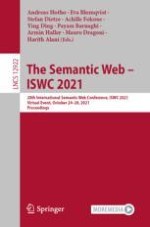This book constitutes the proceedings of the 20th International Semantic Web Conference, ISWC 2021, which took place in October 2021. Due to COVID-19 pandemic the conference was held virtually.
The papers included in this volume deal with the latest advances in fundamental research, innovative technology, and applications of the Semantic Web, linked data, knowledge graphs, and knowledge processing on the Web. Papers are organized in a research track, resources and in-use track. The research track details theoretical, analytical and empirical aspects of the Semantic Web and its intersection with other disciplines. The resources track promotes the sharing of resources which support, enable or utilize semantic web research, including datasets, ontologies, software, and benchmarks. And finally, the in-use-track is dedicated to novel and significant research contributions addressing theoretical, analytical and empirical aspects of the Semantic Web and its intersection with other disciplines.
